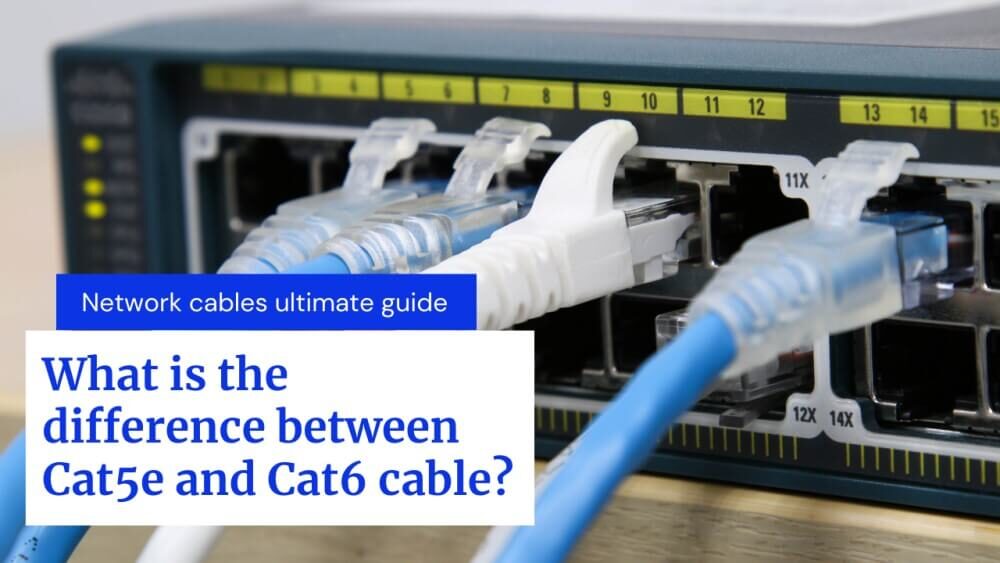Technology is advancing at a rapid pace and so does ethernet cables. After every couple of years, a new ethernet cable is introduced that takes data transfer rates and bandwidth capacities to new heights while offering a whole new level of connectivity. Most commonly available ethernet cables these days are Cat5e Cable, Cat6 Cable, Cat7 Cable, and Cat8 cable.
For residential and commercial purposes, the most in-demand cables are Cat5e Ethernet Cable and Cat6 Ethernet Cable. But which of the two is better for you? Let’s find out.
Cat5e Cable
Cat5e cable is one of the finest and premium ethernet cables out there on the market. It is a 5th category cable but an enhanced one. The cable provides data transfer rates of 1 Gbps and 100 Mbps; maximum data transfer speed is achieved when the cable run is up to 50 meters or 164 feet whereas the minimum data transfer rates are achieved when the cable run is up to 100 meters or 328 feet.
When it comes to the bandwidth capacity of Cat5e ethernet cable, the TIA/EIA standards state that the fifth category should have a minimum bandwidth capacity of 100 MHz. But there are some top-notch manufacturers out there who make Cat5e cable that exhibits a bandwidth capacity of 350 MHz. Higher frequency means optimum connectivity.
The cable is available in the following variants:
- Plenum
- Riser
- PVC
- Direct Burial
Let’s discuss each of them briefly.
The plenum variant of Cat5e Cable is identified from the CMP-rated thick outer jacket that is not only UV-resistant but has fire-retardant properties, too. It means that if a fire erupts, the plenum jacket will emit no perilous gases or smoke while halting its progression at the same time. Yes, you suggest it right: plenum jackets are used in the plenum spaces of the buildings.
As the jacket is thick, it provides excellent protection against all outside interferences such as crosstalk and electromagnetic interference. You are legally authorized to run Cat5e plenum cables in the riser and outdoor spaces. However, the same can’t be reversed owing to fire-related safety concerns.
The riser variant of the Cat5e ethernet cable is a purpose-built ethernet cable variant designed for installation in the high-risk riser spaces of the buildings. This variant too has excellent protection against the crosstalk and EMI. Also, riser cables possess excellent UV and fire-retardant properties.
PVC cables are needed for a run in harsh outdoor or external atmosphere conditions. Due to the very same reason, the cables are called outdoor cables. The outer jacket is designed to provide top-notch protection against sunlight and other harsh weather conditions.
Direct burial Cat5e ethernet cables find their usage in underground installations These cables come with LLDPE jackets that are waterproof and also have excellent protection against insects.
The inner structure of all four variants is the same. It consists of 8 conductors that are either made up of pure copper or copper-clad aluminum. These 8 conductors are tightly-bundled to keep external and internal interferences at bay so that you get optimum-level connectivity. The Cat5e cable runs 24AWG and meets TIA/EIA, CE, CSE, ISO/IES standards and is also in compliance with RoHS.
Now, let’s move the Category 6 cable and find out what makes it different from the Cat5e.
Cat6 Cable
Cat6 Ethernet cable belongs to the 6th category of the ethernet cable. The only two factors that differentiate it from the fifth category cable are data transfer speed and bandwidth.
While the maximum data transfer rate of Cat5e stands at 1 Gbps, the Cat6 cable’s limit for the same stands at 10 Gbps, which is 10 times faster. The same goes for the minimum data transfer rates, i-e, Cat6 offers a minimum data transfer rate of 1 Gbps that is again 10 times higher than Cat5e.
Moving on to the bandwidth capacity, TIA/EIA standards state that a 6th category cable should have a bandwidth capacity of 550 MHz. But there are manufacturers out there on the market that offer Cat6 cable with a bandwidth capacity of up to 750 MHz.
It also comes in 4 variants: plenum, riser, PVC, and direct burial, and jackets of all these variants have exactly the same properties as that of Cat5e cable. The number of conductors are 8 that are made up of pure copper or copper-clad aluminum.
Cat5e vs Cat6: Which one is better for me?
It only depends on one factor and that is your requirements.
While Cat5e cable is preferred in residential spaces, Cat6 ethernet cable remains a popular choice for installation in commercial spaces.
The other factor that may influence the decision is the price factor. If there are budget constraints, then Cat5e emerges as the best option. However, if budget is not an issue, then, you should go with Cat6 cable.
